Over the last 15 years, public Power Five schools have spent an average of roughly three-quarters of a million dollars per school per school year on severance payments for former football and men’s basketball coaches and administrative personnel.
AthleticDirectorU compiled NCAA Financial Reports via public records requests for the 52 public Power Five universities and found that they spent a combined $491,770,668 in the 648 individual school years examined on football and men’s basketball severance payments – an average of $758,905 per school per school year. You can view the complete database here.
That number is greatly skewed by a spike in severance payments in the last two years, however. The average Power Five severance payments for football and men’s basketball combined was roughly three times that amount in 2018.
Remarkably, a few schools reported no spending on football and men’s basketball buyouts since 2005, according to their available NCAA Financial Reports, while some spent in excess of $25 million during that same timeframe.
The amount of severance payments paid by Power Five schools – both the size of the checks and the frequency that schools paid their former staffers – increased significantly last decade but especially in the last two years.

In the 2005 fiscal year, the 34 public Power Five schools for which ADU obtained their NCAA Financial Report spent an average of roughly $235,000 on football and men’s basketball severance payments. That number decreased in each of the next two years, bottoming out around $176,000 in FY07. From FY08 to FY18, that average jumped from $293,000 to $2.3M.
In 2018, the 51 public Power Five schools whose NCAA Financial Report listed their severance payments spent a combined $119M on football and men’s basketball severance payments, which makes up roughly a quarter of the total severance payments in the two sports during the last 15 years.
The increased spending on severance payments makes sense since the value of coaching contracts has increased. That’s pretty self-explanatory – the more it costs to hire coaches means the more it costs to fire them. But not only are the metaphorical horses on the coaching carousel now larger and more expensive but the carousel is also spinning faster. More schools are making more coaching changes more frequently.
In 2005, 19 of the 34 public Power Five schools for which ADU obtained an NCAA Financial Report reported no spending on football and men’s basketball severance payments. That’s 55.9 percent of the schools examined that kept their football and men’s basketball staffs intact, or at the very least didn’t force a coaching change on their own accord.
That percentage climbed to 58.8 percent in 2006 and 2007 (20 out of 34 schools reported no severance payments for those two sports) but the percent of public Power Five schools that haven’t spent any money on football and men’s basketball severance payments has been below 35 percent in each of the last three years.
That’s a decrease of roughly 20 percent points in about a decade.
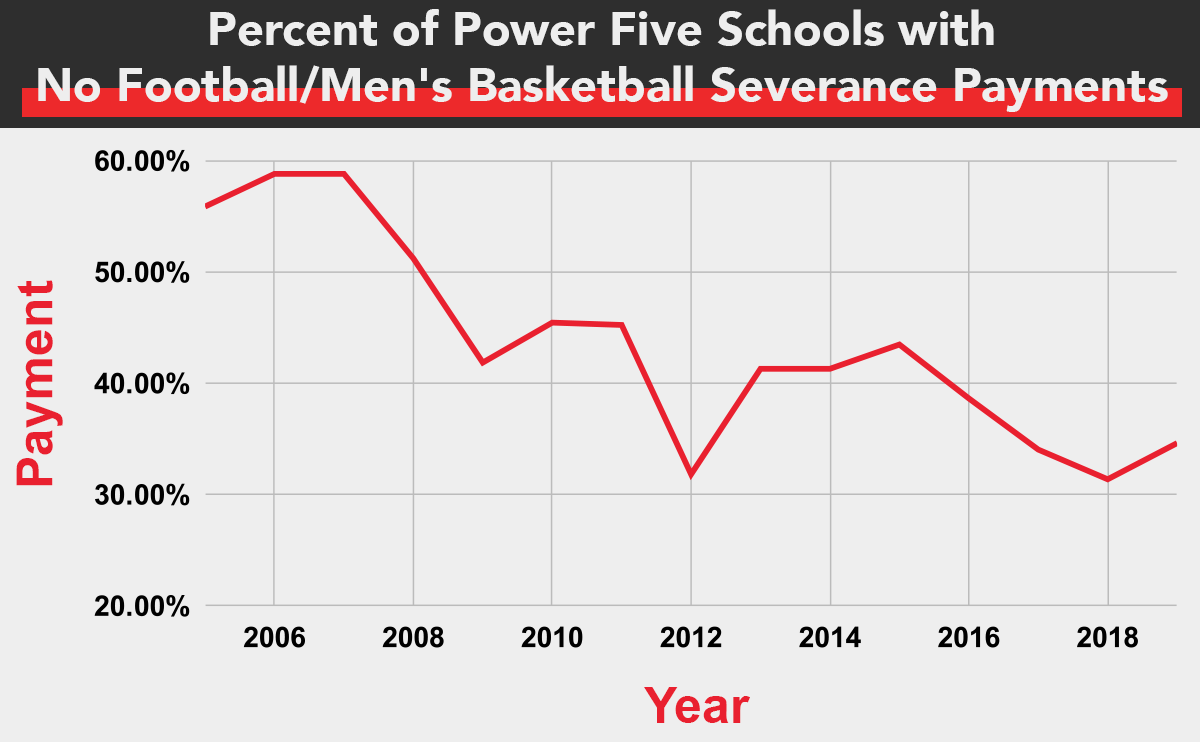
Here are the 10 schools that have spent the most money on football and men’s basketball severance payments over the last 15 years, based on the NCAA Financial Report data available (number of years of data examined in parentheses):
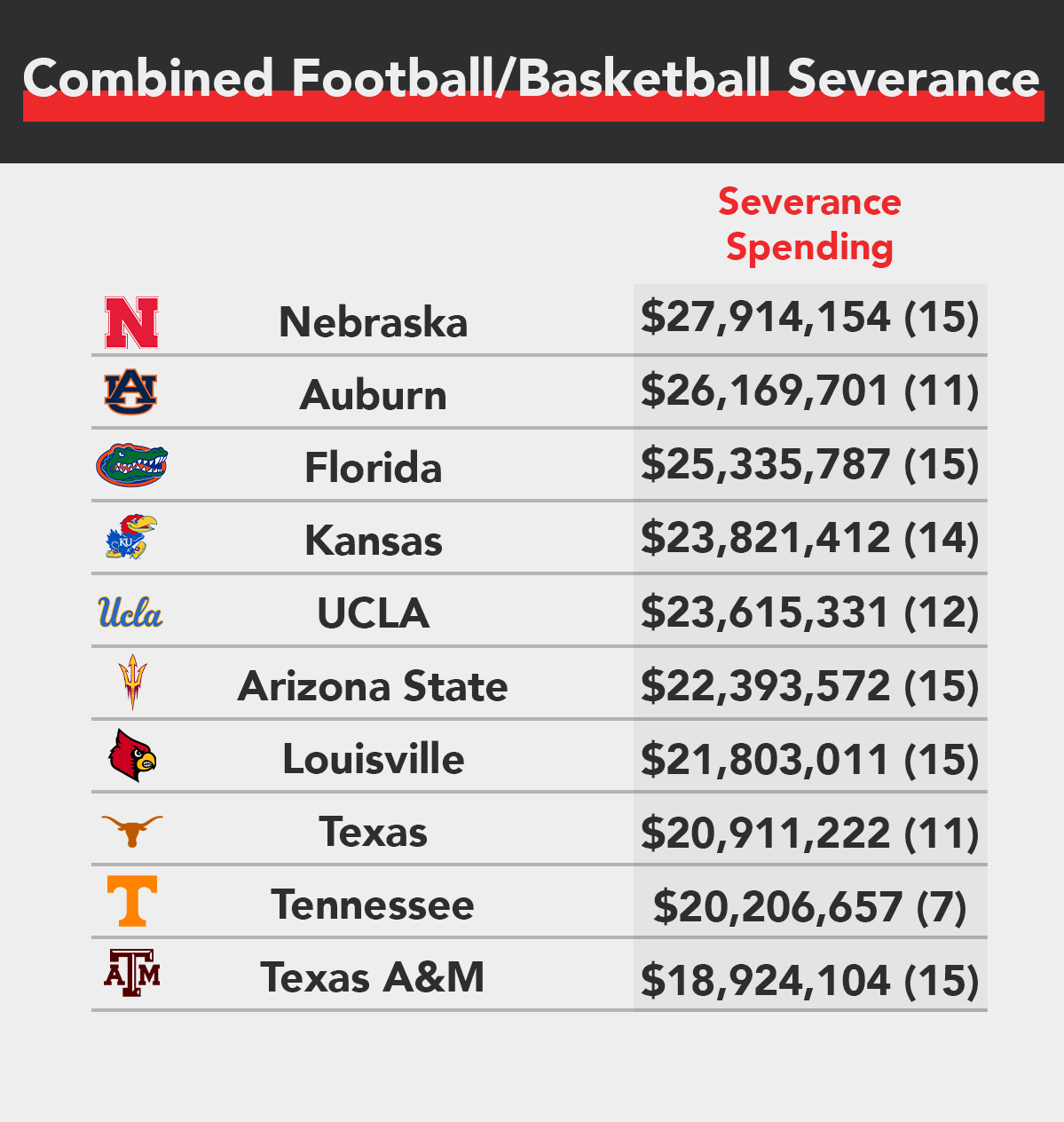
Since not every school’s NCAA Financial Reports are available for the last 15 years, it’s beneficial to look at which schools have spent the most on football and men’s basketball severance on average (number of years of data examined in parentheses):
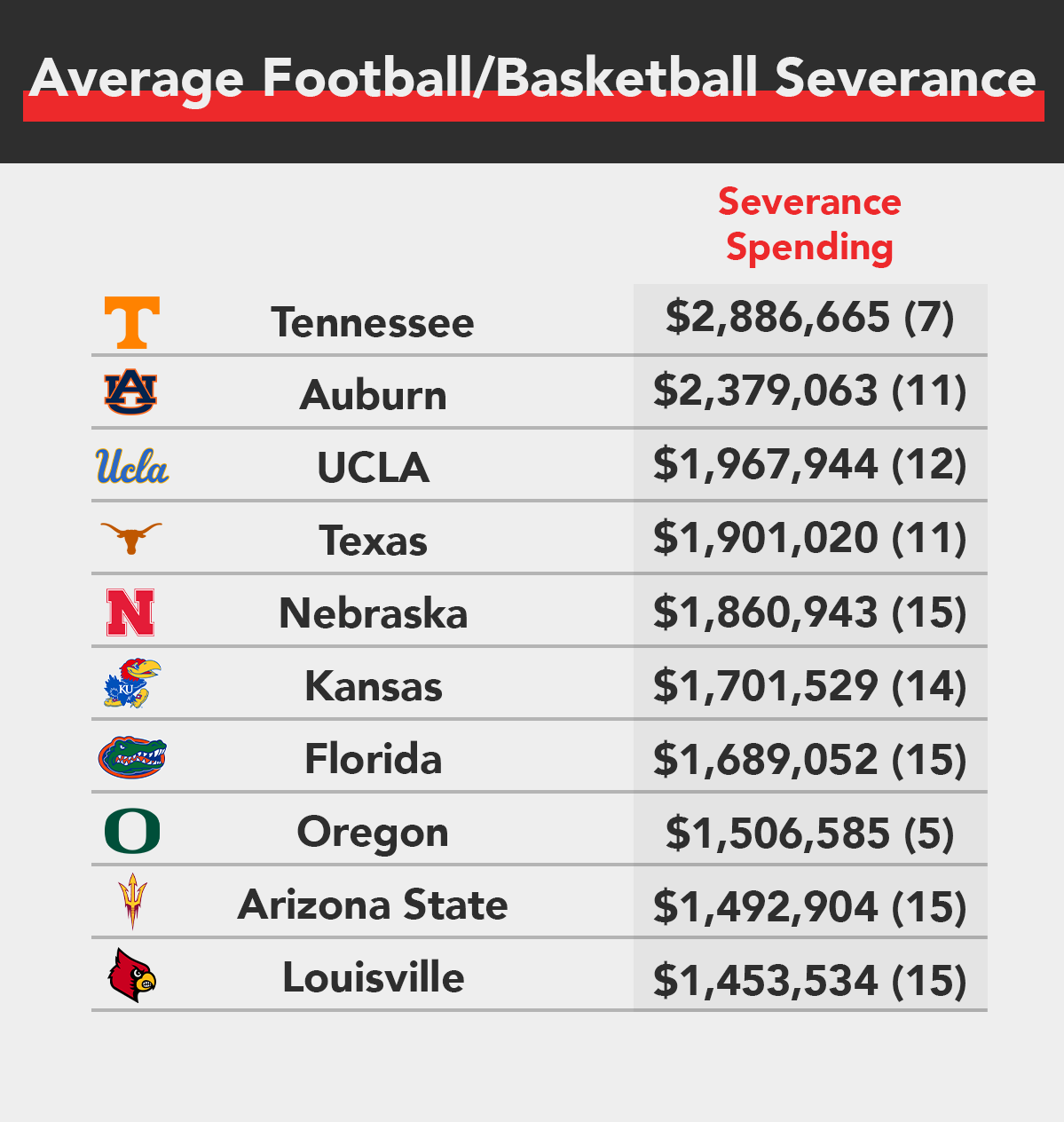
The following graphic shows the 10 highest annual football or men’s basketball severance payments among public Power Five schools over the last 15 years, based on available data.
As you’ll notice, there are several years in which a school ranked among the top 10 overall severance payments among Power Five schools for both football and men’s basketball – Indiana in 2006, Alabama in 2008, Auburn and Virginia in 2009, and Illinois in 2012. Auburn and UCLA were the only two schools that had an average annual football and men’s basketball severance payment that ranked in the top 10 in both sports, based on available data.
College Football Buyouts
During the 2019 fiscal year, the 52 public Power Five universities spent an average of $1,187,159 per school on college football severance payments, which is roughly 8.6 times their average severance payment per school from 15 years ago. While FY19’s average Power Five severance payment of $1.187M was a year-over-year decrease from FY18’s average of $1.9M, it still continued a general upward trend for the sport, when compared to data from the last 15 years. The number of head coach firings (and therefore, related assistant coach and personnel firings) in a given season obviously affect the year’s average.
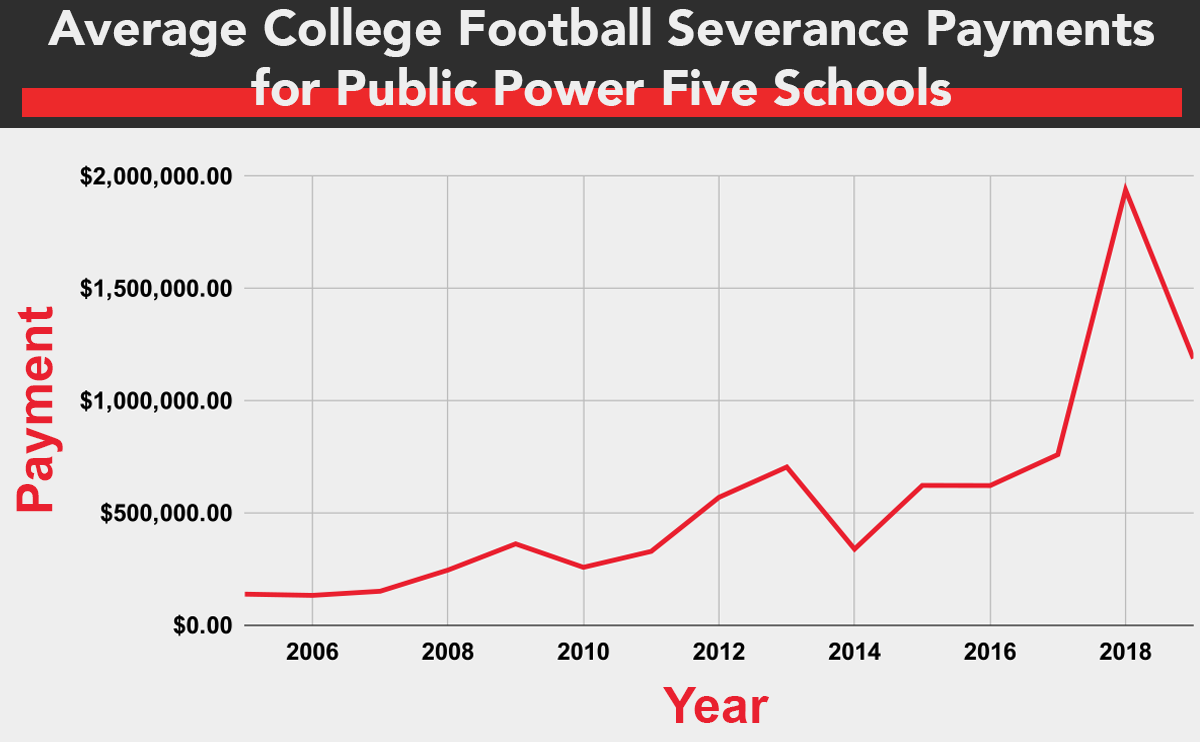
In 2018, five of the 52 public Power Five schools spent more than $10 million in severance payments – Arizona State ($12.8M), UCLA ($12.5M), Florida ($12.2M), Nebraska ($11.9M) and Tennessee ($11.5M) – which is why the average severance payment was almost $2 million per school across the sport’s five biggest conferences. Three other schools spent at least $7 million – Arizona ($8.2M), Texas A&M ($7.7M) and Texas ($7.2M).
In total, the 52 public Power Five schools spent $98 million on severance payments in 2018, while the 47 public Power Five schools for which ADU obtained 2017 NCAA Financial Reports combined to spend just $35 million the year prior.
On the other end of the spectrum, the number of schools that aren’t paying any money in severance is also decreasing. ADU obtained the 2005 NCAA Financial Reports for 34 of the 52 public Power Five schools and 23 of those 34 schools didn’t report any money paid in severance to former football coaches or administrative personnel 15 years ago. That’s 67.6 percent of schools that kept their staff or only had coaches leave on their own volition. In 2006, the number climbed to 70.6 percent (24 of the 34 schools whose reports we’ve collected) and it returned to 67.6 percent in 2007. In the middle of the lifespan of the BCS system, a little more than two-thirds of Power Five schools didn’t owe any former coaches or personnel severance payments on an annual basis.
Now, the pendulum has swung in the opposite direction and almost 60 percent of Power Five schools are writing severance checks annually, whether it’s $100,000 or $10 million. In 2019, just 22 of the 52 public Power Five schools reported no spending on college football severance payments. That’s 42.3 percent – just the second-lowest percent since 2005. In 2016, just 17 of the 44 schools for which we have NCAA Financial Reports didn’t report any college football severance payments, for a decade-and-a-half-low of 38.6 percent.
In each of the last five years, more than half of the public Power Five schools have reported paying severance of some kind on an annual basis. Even if schools report seemingly modest amounts of severance payments – for example, Virginia Tech reported $104,153 in FY19 – that spending still contributes to the overall total, along with the schools that are spending eight figures in a single year. Virginia Tech’s 2019 football severance payments would’ve ranked as the ninth-highest amount among the 34 schools examined for the 2005 fiscal year, 11th out of 44 schools in 2010 and 18th out of 46 schools in 2015. Last year, the university was exactly in the middle of the pack of its peers, ranking 26th out of 52 public Power Five schools in severance payments.
Among the 28 public Power Five schools for which Athletic Director U obtained each of their last 15 NCAA Financial Reports dating back to 2005, there are just two schools that reported zero dollars in college football severance payments during that entire span. Care to venture a guess on who they are?
That would be Iowa and Missouri. Forget college football, Iowa coach Kirk Ferentz is one of the longest-tenured coaches in all of sports, having led the Hawkeyes since 1999. Longtime Missouri coach Gary Pinkel retired in 2015 after a 15-year tenure, leading to the hiring of Barry Odom.
It pays to win – or maybe more accurately, it saves you money to keep a coach after lots of 8-5-type seasons for the promise of the two or three double-digit-win seasons they produce every decade. That’s true in the cases of Iowa and Missouri, at least.
On the other end of the spectrum, there are schools that have spent a lot, lot more than $0 for their coaches to go away in the last 15 years. Based on the data compiled by AthleticDirectorU, which doesn’t include every school for every year because some schools’ reports are unavailable, Florida and Nebraska are neck-and-neck for the title of the public Power Five school that has spent the most on college football severance payments in the last 15 years.
Florida has spent $24,891,148 on football severance payments since the 2005 fiscal year, just ahead of Nebraska at $24,340,701. ADU obtained every NCAA Financial Report from 2005 through 2019 for both schools. The last year that Nebraska didn’t spend any money on severance payments was 2014 – that was also $20.2 million ago. Other than a unique reporting entry in which Florida actually received roughly $40,000 in severance payments in 2016, the last time the Gators’ reported severance payments was exactly $0 was in 2007 – the year in between their last two national titles.
The following graphic shows the 10 public Power Five schools that have spent the most on college football severance payments annually since 2005, based on the data available to ADU.
Here are the 10 public Power Five schools that have spent the most on college football severance payments since 2005:
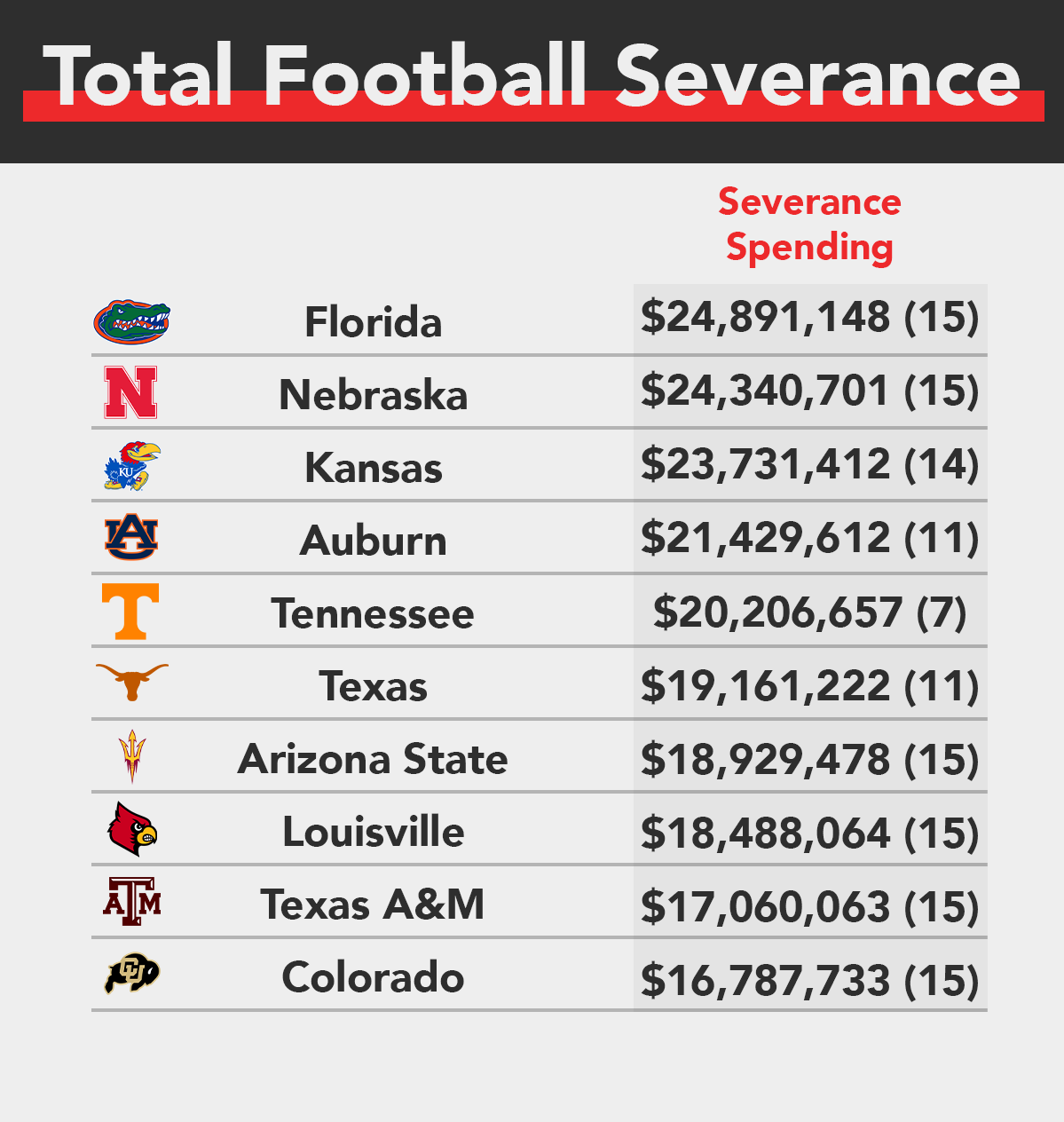
What’s remarkable is that Louisville cracked the top 10 – and almost the top five – despite not reporting any severance payments from 2005-08, in 2011 or from 2014-18. From 2005 through 2018, the university reported just shy of $1.5 million total on football severance payments. Then the university let go of former coach Bobby Petrino. That led to $16,999,251 in reported severance payments last fiscal year – the highest single-school, single-year payment among the data ADU compiled.
The following line chart shows the maximum college football severance payment each year compared to the average severance payment for each of the last 15 years, based on the available data.
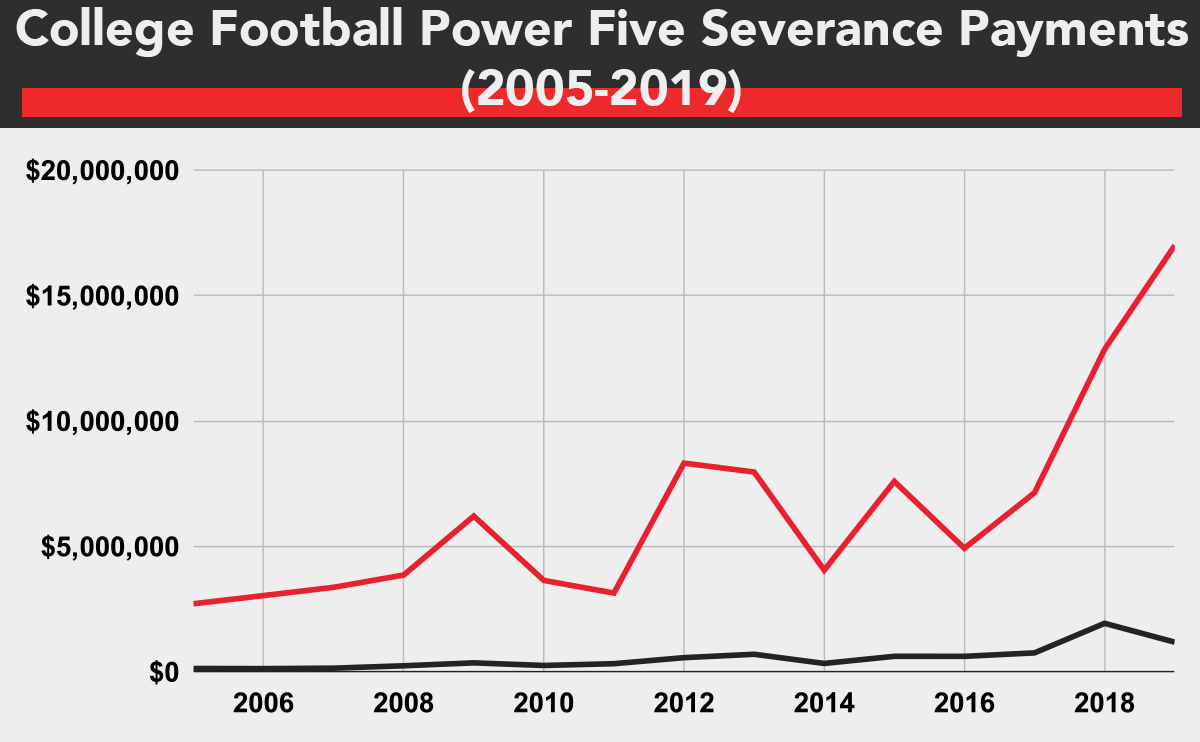
Notice that the average annual Power Five severance payment ($1.9M in 2018, almost $1.2 M in 2019) is gradually approaching the highest reported severance payment in 2005 among the schools we’ve obtained (Florida’s $2.7M in severance). By the way, the second-highest reported severance payment in 2005 behind Florida was South Carolina’s $480,000.
What was once a statistical outlier could be the national average in another five years. Here’s the same data from the list above but this time it’s displayed in a graphic that shows the cumulative college football severance payments for public Power Five schools, starting in 2005. Note that some data is unavailable.
Since we have 14 years of data for Kansas and only seven for Tennessee, perhaps a more accurate portrait of the schools that have spent the most on severance payments is on an average annual basis, by taking the reported total in severance payments divided by the number of years for which data is available. Here are the 10 public Power Five schools that have spent the most on a per-year basis on college football severance payments from 2005 through 2019, based on the data we’ve compiled :

When you look at the 10 schools that have spent the most on college football severance payments – whether it’s in gross spending or average annual spending – you’ll notice that high-level spending doesn’t necessarily discriminate based on geography, conference or historical success (or the lack thereof).
Florida (2006, 2008 national champion) is first nationally in reported severance payments over the last 15 years, based on the data ADU obtained. Auburn won the 2010 national title and it ranks fourth in gross severance spending (despite four years of data being unavailable) and second on a per-year basis.
Texas won the 2005 national championship (the first year examined in this study) and it’s one of the biggest brands in college athletics, and it ranks sixth in total severance payments over the last 15 years – despite four years of its data being unavailable.
Former powers Nebraska and Tennessee rank in the top 10 in gross and annual average spending on severance payments. But so does Kansas, which had a winless season just five years ago.
Arizona State and Colorado rank higher in money spent on severance payments in the last decade and a half than they usually rank in the AP poll.
Here’s a conference-by-conference breakdown of how much each Power Five conference has spent, on average, per public school per season, based on data ADU compiled:
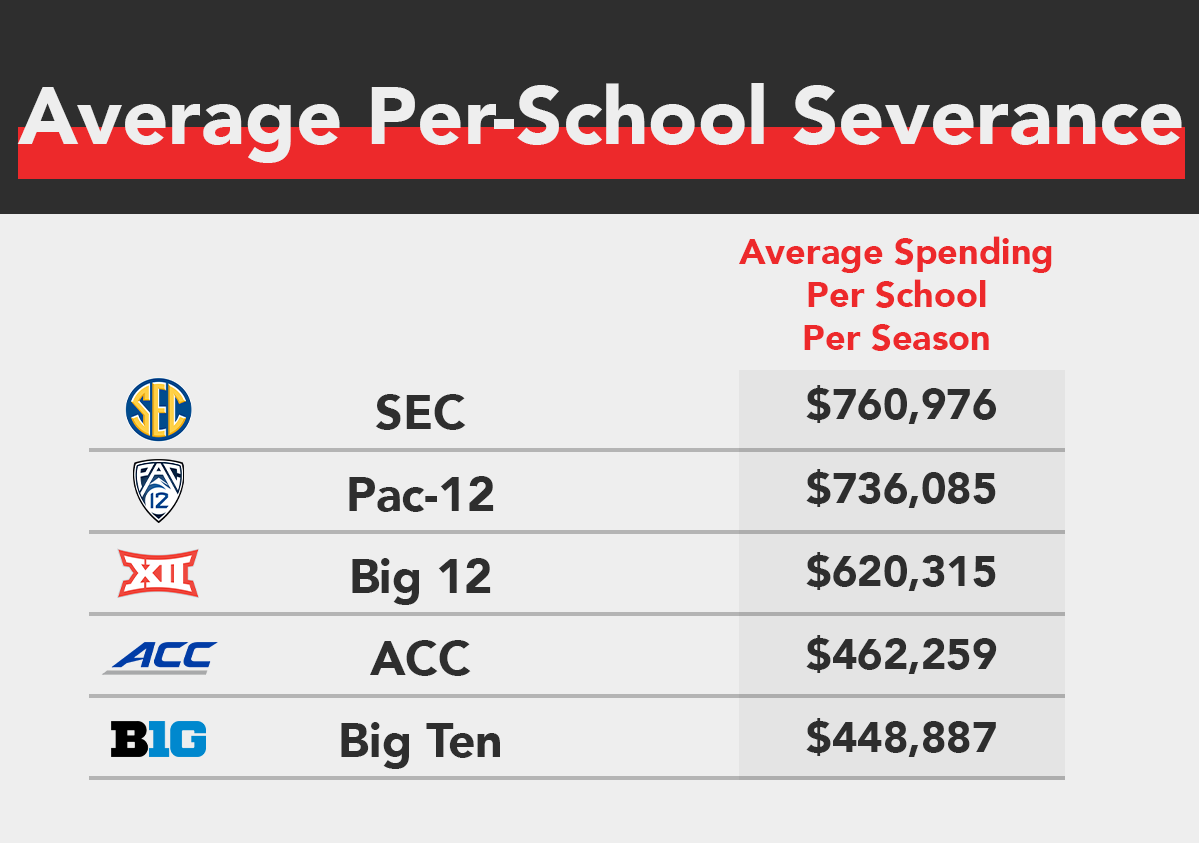
In addition to these numbers indicating the rising cost of coaching hires (and firings, when a tenure doesn’t work out), they can be a proxy for volatility. It shouldn’t be a surprise to read that Ohio State has spent just shy of $1.5 million on football severance payments since 2005 and that LSU has spent just $90,000 more than the Buckeyes over the same time frame. Schools with long-tenured head coaches and schools that have succession plans or that have proven their ability to hire successful replacements often have their decisions pay off on the field in terms of wins, which saves them from paying severance off the field.
College Basketball Buyouts
There’s a pretty good chance football is the first sport you think of when you think of University of Alabama athletics but the Crimson Tide has the distinction of spending the most money on men’s basketball severance payments to former coaches and administrative personnel, based on available data. Alabama has spent just over $8 million on men’s basketball severance payments since 2005 – $5.6 million of which came last fiscal year.
Here are the 10 public Power Five schools that have the highest annual average on men’s basketball severance payments based on available data (minimum five years of data available; number of years examined in parentheses):

The graphic below shows the top 10 spenders annually on men’s basketball severance payments among Power Five schools, based on available data:
From 2005 through 2009, the average annual men’s basketball severance payment per school per school year was less than $100,000, based on available data. In FY07, the 34 schools examined spent an average of just over $25,000 on men’s basketball severance. From FY09 to FY10, the average almost doubled, jumping from roughly $95,000 to over $176,000.
But that percentage increase was later dwarfed by the spike from FY17 to FY18, when public Power Five schools spent three times as much on men’s basketball severance in 2018 ($398,464) compared to 2017 ($133,677), on average. The average severance payments per school last year was $246,770 – a decrease from FY18 but still clearly the second-highest average annual payment in the last 15 years.
Based on data available to ADU, public Power Five schools have spent much less in the last decade and a half on men’s basketball severance than football ($390M among the schools and years examined), but it’s still a massive number: $101,717,692.


